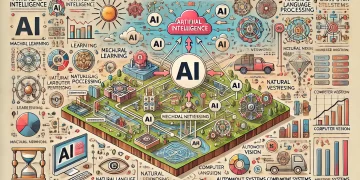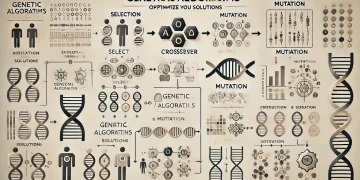Imagine a bank that can instantly assess loan applications, offering fair interest rates based on a customer’s financial history. Or an online security system that detects cyber threats before they cause harm. These are real-world examples of how data mining helps businesses and organizations make smarter, data-driven decisions.
Data mining is a branch of artificial intelligence that allows computers to sift through massive amounts of information, uncovering valuable patterns and insights. In today’s digital world, where data is constantly generated—from financial transactions and website activity to social media interactions—organizations rely on data mining to identify risks, improve services, and enhance security.
Digging for Gold in Data
Much like mining for gold, where valuable metal is extracted from tons of rock, data mining helps organizations find crucial patterns hidden within vast amounts of data.
Data Mining Algorithms
There are well over 100 data mining algorithms, but the exact number depends on how they are categorized and defined. These algorithms fall into different types, including:
- Classification algorithms (e.g., Decision Trees, Naïve Bayes, Random Forest)
- Clustering algorithms (e.g., K-Means, DBSCAN, Hierarchical Clustering)
- Association rule learning (e.g., Apriori, FP-Growth)
- Regression algorithms (e.g., Linear Regression, CART)
- Anomaly detection algorithms (e.g., Isolation Forest, LOF)
- Neural networks & deep learning (e.g., CNN, RNN, Transformer models)
- Ensemble methods (e.g., AdaBoost, XGBoost)
Many of these algorithms have variations and improvements, further increasing the total count. However, in practical applications, only a subset of 20–50 key algorithms is widely used.
Some of the most well-known and widely used data mining algorithms include:
- CART (Classification and Regression Trees) – A simple decision tree method that predicts outcomes by asking a series of yes/no questions.
- ID3 (Iterative Dichotomiser 3) – A basic decision tree algorithm that selects the best question at each step to classify data.
- C4.5 – An improved version of ID3 that can handle missing values and is better suited for real-world applications.
- SLIQ (Supervised Learning in Quest) – A decision tree method designed for efficiently analyzing large datasets.
- SPRINT – A scalable decision tree algorithm that processes vast amounts of data without memory limitations.
- DBSCAN (Density-Based Spatial Clustering) – A clustering technique that identifies groups in data based on density while filtering out noise.
- Apriori Algorithm – Identifies frequently occurring patterns in large datasets, commonly used for analyzing shopping behavior.
- Random Forest – A powerful technique that combines multiple decision trees to make more reliable predictions.
- AdaBoost (Adaptive Boosting) – Enhances weak models by learning from their mistakes to create stronger predictions.
- Gradient Boosting (GBM, XGBoost, LightGBM, CatBoost) – Advanced boosting techniques that improve prediction accuracy by iteratively refining errors.
- CHAID (Chi-Square Automatic Interaction Detector) – A decision tree algorithm that uses statistical tests to uncover meaningful patterns in data.
The Data Mining Process
The process of data mining generally follows these steps:
- Identify the problem and gather relevant data.
- Clean and organize the data to remove inconsistencies.
- Analyze the data to find important patterns.
- Build a predictive model, such as a decision tree.
- Test and refine the model for better accuracy.
- Deploy the model for real-world decision-making.
Decision Trees
To illustrate how data mining works, let’s explore two fields where it plays a crucial role:
- Intrusion Detection Systems (IDS): Cybersecurity experts use data mining to identify unusual network behavior that may indicate a cyberattack. By analyzing patterns in normal traffic, an IDS can detect suspicious activity—such as unauthorized access attempts or malware infections—before any damage occurs.
- Loan Assessment: Banks and financial institutions leverage data mining to evaluate loan applications. By analyzing past loan repayment behaviors, income levels, and credit histories, data mining helps assess an applicant’s likelihood of repaying a loan, leading to fairer and more accurate approval decisions.
One powerful data mining technique is decision trees, which classify information through a series of yes/no questions. Next, we will explain how to construct a decision tree for intrusion prevention and loan approval decisions.
Building a Decision Tree for Intrusion Detection Systems
A decision tree helps classify network activity as normal or suspicious based on various attributes.
Step 1: Define the Problem
The goal is to classify incoming network activity as either normal traffic or a potential intrusion (e.g., malware, brute force attack, unauthorized login).
Step 2: Collect and Prepare the Data
The dataset should include real network traffic data with labeled attributes such as:
- Source IP address (Is it from a trusted network?)
- Destination IP address (Is the target a sensitive server?)
- Port number (Is it using a commonly exploited port?)
- Protocol type (Is it HTTP, SSH, etc.?)
- Number of failed login attempts (Is there unusual login behavior?)
- Data packet size (Are there abnormal packet sizes?)
- Time of access (Is the activity occurring at odd hours?)
- Known threat signatures (Does the pattern match any known attacks?)
Step 3: Select Important Features
Using statistical analysis or machine learning techniques, we determine which factors contribute most to identifying intrusions.
Step 4: Build the Decision Tree
Example decision tree structure:
- Has the user exceeded three failed login attempts?
- Yes → Possible intrusion → Move to next check
- No → Normal activity
- Is the IP address from a known suspicious source?
- Yes → High likelihood of intrusion
- No → Move to next check
- Is the request targeting a sensitive system (e.g., database server)?
- Yes → Very high risk → Block immediately
- No → Monitor further activity
- Is the packet size unusually large or small?
- Yes → Flag for review
- No → Normal activity
Step 5: Train the Model
- The decision tree is trained using a dataset of past network traffic.
- It learns which patterns are normal and which indicate an attack.
- Over time, the tree is refined to improve accuracy.
Step 6: Test and Deploy
- We test the model using new, unseen network activity.
- If it successfully identifies intrusions, it is deployed into an automated security system.
- The model is continuously updated to recognize new cyber threats.
Building a Decision Tree for Loan Assessment
A loan assessment model helps banks decide whether to approve or deny loan applications based on financial history, income, and credit behavior.
Step 1: Define the Problem
The goal is to classify a loan applicant as approved or denied based on past financial data.
Step 2: Collect and Prepare the Data
The dataset should contain labeled examples of past applicants, with attributes such as:
- Income level (Does the applicant earn enough to repay?)
- Credit score (Does the applicant have a history of paying loans on time?)
- Debt-to-income ratio (How much of their income is already committed to loans?)
- Employment stability (Do they have a stable job?)
- Loan amount requested (Is it reasonable compared to their income?)
- Past loan repayment history (Have they defaulted before?)
Step 3: Select Important Features
Using statistical analysis, we determine which features most impact loan approvals.
Step 4: Build the Decision Tree
Example decision tree structure:
- Does the applicant have a credit score above 700?
- Yes → Likely approved → Move to next check
- No → Move to next check
- Is the debt-to-income ratio below 40%?
- Yes → Likely approved
- No → Move to next check
- Has the applicant ever defaulted on a loan?
- Yes → High risk → Likely denied
- No → Move to next check
- Does the applicant have stable employment (more than 2 years)?
- Yes → Approve loan
- No → Deny or require additional checks
Conclusion
Data mining offers numerous benefits, including enhanced security, improved decision-making, and streamlined financial services. It helps detect fraud, assess risks, and optimize business operations. However, it also has limitations, such as data privacy concerns, potential biases in algorithms, and the need for high-quality data.



































